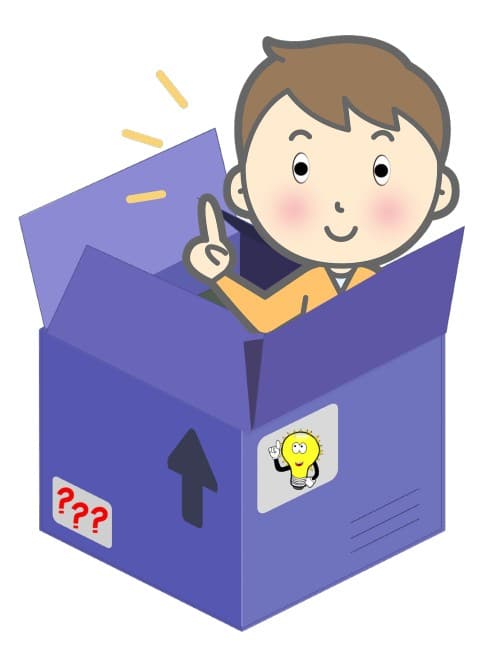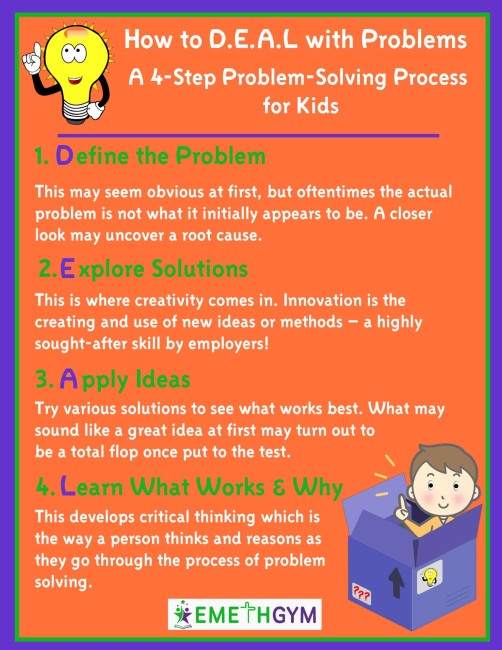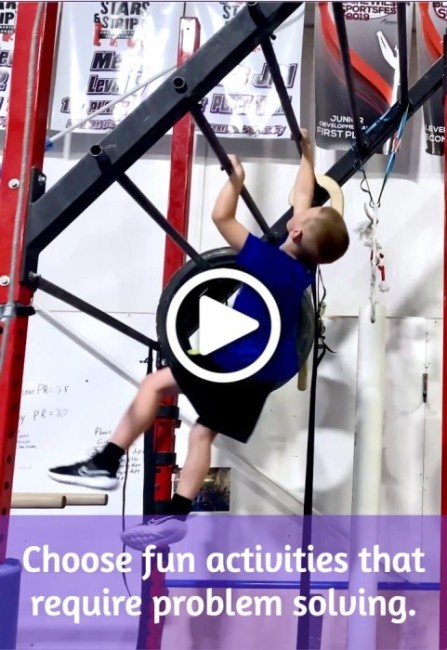Teach Your Kids to Be Creative Problem Solvers!
Problem solving is a necessary life skill. Why? Because every single day we’re faced with problems that need solving! Whether we’re talking about adults or children, each day brings a new assortment of problems we must deal with.
For the toddler, this may be, “How can I get the cereal to stay on my spoon until it’s in my mouth?” The 5-year-old wonders, “Why can’t I put my hair up in a pony tail like mom does?” The child who just moved laments, “I have no friends anymore! How do I make new ones?”
Kids may learn problem solving on their own after lots of trial and error. But parents can make it a lot easier – and even fun – by introducing a simple step-by-step approach. This teaches them to think critically by analyzing the problem, dreaming up some possible solutions, then testing them out.
Creative problem solvers are innovative, think outside the box, and bring fresh new perspectives and solutions to those they live and work with.

What Is Problem Solving?
Problem solving is the process of identifying a problem, developing possible solutions, then testing those solutions to see which one is best. Without problem-solving skills, you’re left with nothing but frustration. One of the most valuable skills you can give your kids is the ability to solve problems. Without this skill, people become casualties of life’s struggles rather than conquerors.
How to Teach Creative Problem Solving to Kids
Introduce your kids to new places and situations on a regular basis. This expands opportunities for new mental and physical challenges to grapple with. Teach them a problem-solving process when they encounter a difficulty.
Remember – not all problems are unwelcome! Many can be fun challenges they enjoy. This is the time to guide them through the steps of solving a problem. Don’t wait until they’re in the midst of a nasty difficulty when all they want is for it go away.
Encourage curiosity and exploration.
Playgrounds, local parks, and museums are excellent choices for exploratory learning. Apply the DEAL method in these possible scenarios.
- Your 3-year-old is at the playground and wonders, “How can I walk across this wobbly rope bridge?”
- Take your child to the park. Tell him he’s going to be the guide to lead the way back on a new trail you just led him down. This also teaches attentiveness, develops directional skills, and could involve lots of creative thinking! (Remember Hansel and Gretle?)
Hands-on museums and science centers are other great places where kids can explore ways to solve problems.
Toys and games also offer many opportunities for problem solving. Watch your little one as she figures out how to keep her block tower from toppling over. Send teams of kids on a scavenger hunt to figure out where the ‘treasure’ lies. They will need to interpret clues along the way. They also learn teamwork and how to work together to brainstorm possible solutions.
Foster a growth mindset toward problem solving.
Problem solving requires perseverance. It’s easy to throw in the towel when failure occurs. Too often kids consider themselves to be the failure rather than the solution they tried. Help kids separate the two by instilling a growth mindset.
“What did you learn from this?”
“That one didn’t work, so let’s move onto the next idea.”
“You now know three reasons why the pancakes didn’t turn out: too much flour, the burner was too hot, and not enough sweetener. You’re getting closer to making the perfect pancake!”
Remind kids it’s about learning. The learning process is important. It instills the kind of character needed to come up with creative solutions.
DEAL with problems as they arise.
This is a simple, easy-to-remember approach to problem solving. DEAL is an acronym that teaches kids a simple way to deal with problems using a four step process.
- Define the problem.
This may seem obvious at first, but oftentimes the actual problem is not what it initially appears to be. A closer look may uncover a root cause. - Explore solutions.
This is where creativity comes in. Innovation is the creating and use of new ideas or methods – a highly sought-after skill by employers! - Apply ideas.
Try various solutions to see what works best. What may sound like a great idea at first may turn out to be a total flop once put to the test. (‘Experience is the best teacher’ applies here!) - Learn what works best and why.
This develops critical thinking which is the way a person thinks and reasons as they go through the process of problem solving.
Choose fun activities that require problem solving.
It’s so easy in today’s world to just look up the answers to problems. That’s great for some things like finding directions to Nowhere, CO or Jot Em Down, TX. But if you want to get in better shape, you can look up all the ways to do so without ever solving the problem. You must DEAL with the problem by taking action.
Finding fun activities that also encourage problem solving can be a challenge. One of the best activities is to get them engaged in certain sports programs. Golf, archery, and ninja classes for kids are all great choices. Not only do these provide ongoing problem-solving opportunities, they’re also fun fitness choices.
For instance, with ninja training, kids must figure out how to quickly maneuver through obstacle courses. This develops gross and fine motor skills, strength, balance, speed and much more.
Try a Free Ninja Class
Schedule Your TrialHere’s an example of how a student enrolled in a ninja class could follow the DEAL steps for problem solving:
Define the problem. Johnny can’t seem to improve his time no matter how hard he tries. He’s just not fast enough on the course.
Explore solutions. Possible solutions may include:
- Spend time out of class doing sprints and interval training to increase his speed.
- Record himself during class and look for areas he might improve.
- Watch videos of others and compare.
Apply ideas. After implementing all the ideas, he discovered that the problem wasn’t that he needed to work on his speed. He was actually very fast. It was his lack of flexibility in his hamstrings. He had to take a small extra step after landing on each block he leaped to before taking off for the next one. Adding flexibility exercises to his workouts was the solution. Johnny was able to leap from one block to the next with no extra step. This saved him several seconds on his overall time.
Learn what works best and why. It was only after Johnny compared video recordings that he discovered why the first idea didn’t work. By analyzing the recordings, he engaged his critical thinking skills which helped him solve the problem.
Teach kids to think outside the box.
First – reduce screen time! Screen time is a passive activity and needs little or no imagination or creativity.
Schedule creative play time into your child’s day from an early age. Here are a few suggestions for items that encourage the art of creativity:
- Cardboard boxes of various sizes. Add some bed sheets and ask them if they can make a house with rooms.
- Tangrams. Solve the puzzles on the cards or try fitting pieces together on your own to make a house, car, or animal.
- Felt boards with various items or themes. Create scenes with geometric shapes, zoo animals, food, pets, etc.
- Dress up box full of clothes, shoes, bags, and accessories. Ask them what they would wear to a wedding or as a doctor or nurse.
Play a brainstorming game.
Give your child a common object: paper towel tube(s), ruler, egg carton, brush, etc. Ask her to use her imagination to transform an item into something other than what it is. It’s quite surprising to see what pops into their minds! You may need to go first to encourage those creative juices to start flowing. Perhaps the ruler is now a conductor’s baton. Then it’s a popsicle.
Make it even more fun by having kids guess what the imaginer has imagined! Or give them one minute to use creative thinking to see how many new ideas they conjure up. A great game for a family night!
Benefits of Teaching Creative Problem Solving to Kids
Improved critical thinking skills
Critical thinking is the process of thinking carefully about a subject or idea, without allowing feelings or opinions to affect you. We need to teach our kids to separate themselves from their feelings. This enables them to think more objectively about the problem. Even learning to manage emotions by asking questions like, “Why am I reacting like this?” or “Are my emotions affecting my decisions?” takes some critical thinking!
Increased confidence and self-esteem
The process of solving a problem by applying a creative solution boosts confidence. The bigger the problem and amount of effort put forth makes their confidence soar even more.
Improved communication and interpersonal skills
Solving problems oftentimes needs input from others. Learning to clearly define the problem, brainstorming together, listening and accepting others’ ideas are all part of problem solving. One idea can spark a whole new creative approach to the problem. Taking part in a group discussion with an open mind and controlled emotions is an essential skill.
Conclusion
Until life’s problems go away, creative problem-solvers will always be in high demand. Kids should be trained at a young age to view these difficulties as opportunities for growth.
Teaching kids the steps to solving problems equips them for the future. It prepares them to confront difficulties with more confidence. It enables them to flourish rather than languish when problems arise.
At EmethGym, we think ninja classes are unique. They turn problem solving into a fun activity by creating problems in the form of obstacle courses. Kids get excited about the challenge to master the course. Their view of a problem becomes a learning adventure.
Once a student has conquered a course, they enjoy an immense boost of confidence. They increased their problem-solving skills, gained strength, flexibility, agility and more in the process!
Give your kids valuable problem-solving skills that will benefit them throughout their lives. They’ll become critical thinkers and creative problem solvers. This results in greater success and fulfillment in all areas of life.





